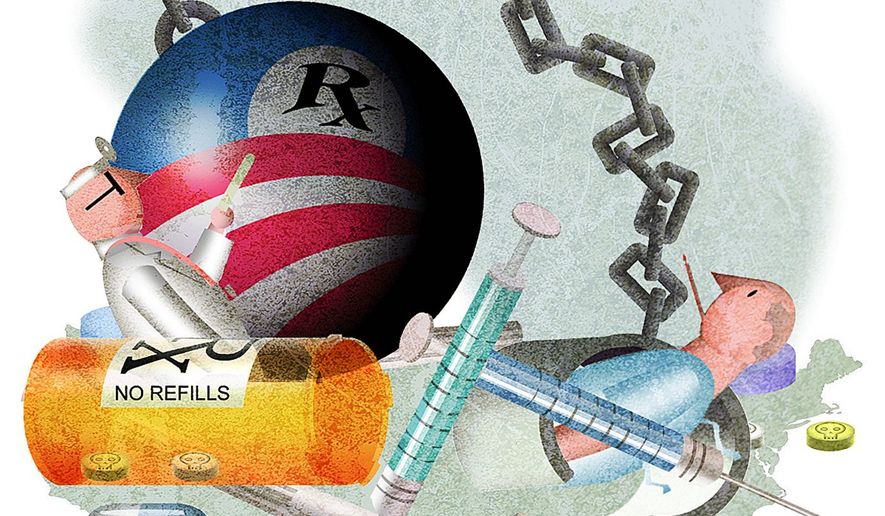OPINION:
Last week’s tax-filing deadline was a little bit more complicated than in the past, thanks to Obamacare.
Americans had to prove to the Internal Revenue Service that they had health insurance last year — or risk a tax penalty. Many of those that shopped in the exchanges, meanwhile, learned that they actually owed the government money because they misreported their incomes when applying for subsidized coverage.
It’s unlikely that these folks would agree with President Obama’s assertion on the law’s recent five-year anniversary that it was working “beyond a shred of a doubt.” Obamacare has failed to increase coverage, deliver affordable care, or significantly improve the economy.
The White House claims that since Obamacare took effect, the number of uninsured Americans has dropped from 48 million to 32 million.
“In just over one year, the ranks of the uninsured have dropped by nearly one-third,” the president said.
But that’s misleading. According to the Census Bureau, the uninsured rate peaked in 2010 at 15.5 percent, four years before the individual mandate kicked in.
As the economy improved, many previously uninsured folks joined the workforce and received health insurance through their employers. That’s partially why the uninsured rate dropped to 14.8 percent in 2012, 14.5 percent in 2013, and 11.9 percent in the first quarter of this year.
Further, in 2014, the Census changed the way that it calculated the uninsured rate. The effect was to show lower estimates of the number of uninsured.
If the decline in the uninsured rate started before the mandate was in place — and if the Census’s new methods are predisposed to find a decline — Obamacare can’t legitimately take credit for it.
Mr. Obama has bragged that his health care law has cut individual health care costs drastically. “Most people,” he said, “have options that cost less than 100 bucks a month.”
Yet premiums have skyrocketed under Obamacare. A recent report from HealthPocket — an online insurance marketplace — revealed that 23-year-old men who have not chosen to stay on their parents’ plans have seen their premiums increase by as much as 78 percent under the law. Premiums for 63-year-old men increased 23 percent.
Women suffered a similar fate. Twenty-three-year-olds experienced premium spikes of 45 percent. Those 63 years of age watched theirs jump 38 percent.
Even premiums for those who receive subsidies have jumped — by 23 percent in the last year. That’s after taking those subsidies into account.
The president has further argued that patients are benefiting because Obamacare moves “toward a payment model that rewards quality of care instead of quantity of care.”
Instead, Obamacare has encouraged health care providers to put a price on each patient’s life. Under the law, some hospitals have begun experimenting with “bundled payments.” Insurers fork over one lump sum for a procedure rather than paying for its individual components. If the hospital can keep costs under the lump sum, it pockets the extra money.
This practice could lead health care providers to discriminate against high-risk patients who amass higher costs. If a patient needs an extra treatment that will exceed the bundle, the hospital will have to choose between its bottom line and the patient’s health.
Bundled payments also encourage “upcoding,” whereby doctors classify a condition as worse than it is to receive a higher lump sum. The practice can force insurers to spend more than necessary.
Finally, the president has tried to make the case that Obamacare hasn’t hurt the economy. “It’s not the ’job-killer’ that critics have warned about,” he said.
Wrong again. As of Jan. 1, Obamacare mandates that companies with more than 100 employees must offer health insurance to those who work more than 30 hours a week. Last year, companies had to shell out an average of $5,000 for each individual getting insurance through the company.
Naturally, companies have attempted to limit the number of full-time employees on their payroll. Staples, which has 85,000 workers, has limited part-timers to 25 hours a week. That trend has spread across the United States. Last year, 2 million people were working two part-time jobs last year — the highest level since the government began keeping track in 1994.
Five years in, Obamacare is every bit the problem opponents said it would be. And that’s what is true “beyond a shred of doubt.”
• Sally C. Pipes is president, CEO and Thomas W. Smith Fellow in health care policy at the Pacific Research Institute. Her latest book is “The Cure for Obamacare” (Encounter, 2013).




Please read our comment policy before commenting.